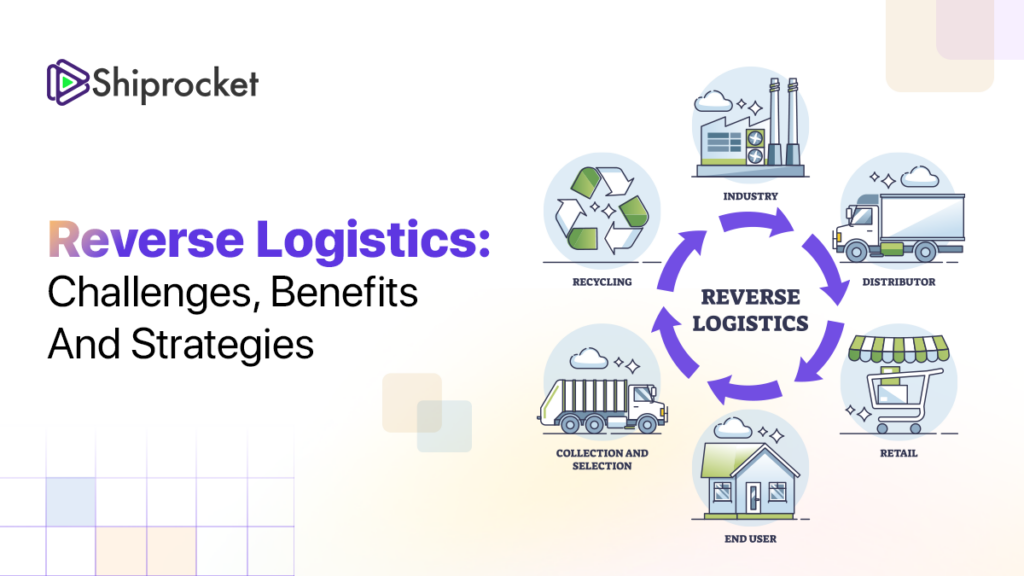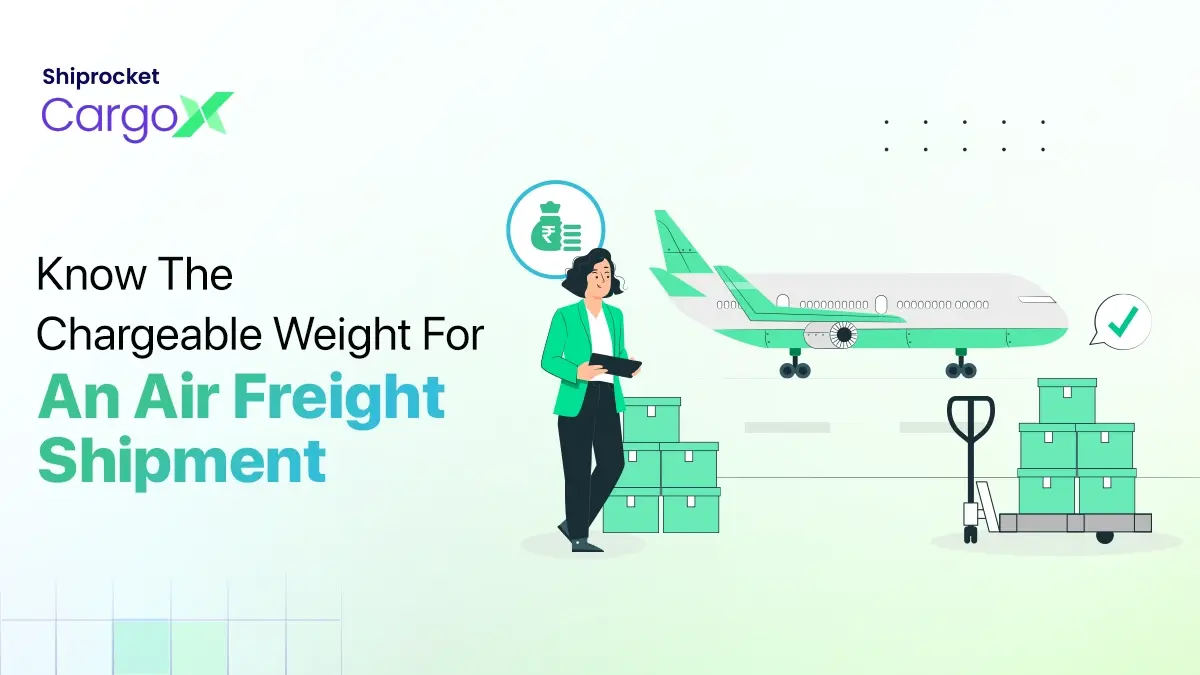Reverse Logistics in 2024: What, When & How
- What Is Reverse Logistics?
- When Is Reverse Logistics Used?
- How Does Reverse Logistics Create Value?
- Categories of Reverse Logistics
- 5 R’s of Reverse Logistics
- Advantages of Effective Reverse Logistics
- Challenges in Reverse Logistics
- Reverse Logistics vs. Reverse Supply Chain?
- 7 Strategic Approach to Improve Reverse Logistics
- Conclusion
eCommerce businesses require managing the flow of goods efficiently not only from manufacturers to consumers but also in the reverse direction. This process is referred to as reverse logistics. While logistics focuses on delivering products to customers, reverse logistics mainly includes product returns.
As per India Reverse Logistics Market Report 2022-2027, the reverse logistics market in India is likely to reach USD 39.81 Bn by the year 2027. The process has its set of benefits and challenges.
In this article, we’ll discuss all about reverse logistics. This includes the strategies employed to streamline the process, the benefits it can yield, and the challenges it involves.

What Is Reverse Logistics?
Reverse logistics mainly involves moving finished goods/ raw materials from the customers back to the manufacturer or supplier. The return, recycling, remanufacturing, and disposal of products and materials after reaching the end consumer are all covered under this process.
This practice is important for reducing waste. It is an effective way to minimise environmental impact and recover value from returned or discarded products. With the help of reverse logistics, companies optimise their supply chains and improve sustainability.
When Is Reverse Logistics Used?
Reverse logistics is mainly used in the post-consumer phase of a product’s lifecycle. It plays a significant role in managing returned goods. It makes sure the product return process runs seamlessly. It is also used during the recycling and remanufacturing of products while managing excessive inventory and for the recovery of packaging materials.
How Does Reverse Logistics Create Value?
Here is how reverse logistics creates value:
- It promotes sustainable business practices by reducing waste and lowering harmful impacts on the environment.
- It helps derive value from returned items.
- It improves customer satisfaction by managing product returns and warranty repairs seamlessly.
Categories of Reverse Logistics
- Product Returns
Businesses use reverse logistics to manage returned goods.
- Remanufacturing and Refurbishing
It also involves disassembling and rebuilding products to add value to them.
- Warranty and Repairs
Service providers use reverse logistics to handle warranty claims and repairs wherein the items need to be picked from the customers.
- Excess Inventory Management
Retailers manage excess or unsold inventory by returning it to suppliers or redistributing it using a reverse logistics process.
- Delivery Failure
In many cases, the driver fails to deliver the product to the consumer because of various reasons. In such a case, he brings the products back to the sorting centers. From there, the products are returned to their original point.
- Recycling and Waste Management
It is also used by organisations during the process of recycling and disposal of products or materials. Waste products are disposed of in an environmentally responsible manner using this process.
- Rentals
When the rental contract of a product or equipment ends, it is returned to its owner with the help of reverse logistics.
- Reusable Packaging
Businesses also use reverse logistics to recover and reuse packaging materials such as containers and crates.
5 R’s of Reverse Logistics
The 5 R’s of Reverse Logistics are as follows:
- Return
The first R is all about managing the returned products. It ensures that the items returned by the consumers are assessed properly and shipped back to the supplier or manufacturer.
- Reselling
Reselling the returned goods to new customers also comes under this process. The returned goods that are unused and in good condition are tagged back into the system for the purpose of reselling.
- Repair
The process also comes into play when a customer wants an item to be repaired. The product is inspected, picked from the customer, and sent for repair.
- Repackage
The returned goods are sent for repackaging using reverse logistics. This helps in optimising the condition of these goods and prepares them for resale.
- Recycle
It promotes the recycling of used products and materials. This helps in lowering landfill waste and building a cleaner and sustainable environment.
Advantages of Effective Reverse Logistics
Let’s take a look at the various advantages of effective reverse logistics:
1. Enhances Customer Satisfaction
This process helps streamline the procedure of return of goods. It also helps in managing the warranty and repair processes effectively. This, in turn, enhances overall customer satisfaction.
2. Promotes Sustainability
It reduces waste in the environment, thereby promoting cleanliness and sustainability.
3. Boosts Credibility
It demonstrates a business’s commitment to environmental responsibility, adding to its credibility.
4. Increases Profitability
Recycling the products and materials helps the companies optimise resource utilisation and recover value.
5. Reduces Risk Management
It helps protect businesses from risks related to the exchange and disposal of products. Some products need to be disposed of immediately because of safety recalls. Reverse logistics addresses this requirement timely.
Challenges in Reverse Logistics
Some of the common reverse logistics challenges are as follows:
- Space Constraints
Businesses often face space constraints when it comes to storing goods that are returned. Statistics reveal that reverse logistics need an average of up to 20% additional space than forward logistics.
- Expensive
It involves a lot of expenses, such as transportation costs, processing expenses, and the cost of inspecting.
- Complicated Returns
Reverse logistics can be a complicated process as it involves a number of steps. This includes inspecting the goods, processing them, repairing, recycling, repackaging, and more.
Reverse Logistics vs. Reverse Supply Chain?
| Points of Distinction | Reverse Logistics | Reverse Supply Chain |
| Definition | Involves the movement of goods from consumers to the manufacturer or supplier. | Involves the movement of goods from consumers to the manufacturer or supplier. |
| Focus | Mainly deals with managing the return of goods with a focus on product recalls and recycling. | Focuses on the process of remanufacturing, refurbishing, and repackaging of goods |
7 Strategic Approach to Improve Reverse Logistics
Improving reverse logistics is crucial for enhancing sustainability and managing costs. Here are seven strategic approaches to achieve this:
- Analyse the Data
Collate necessary data to understand which products are being returned more often. This will also give you an insight into why the products are being returned. You may make modifications to your products to lower the rate of return.
- Review and Modify Return Policies
Review your organisation’s return and repair policies and make strategic changes to ease the reverse logistics process.
- Maintain Cordial Relationships with Suppliers
It is important to maintain a cordial work relationship with the suppliers to ensure a seamless experience.
- Centralise the Return Centers
Establishing a central return center assists you in categorizing products and determining their true worth. It also makes it easier for businesses to figure out what to do with returned goods.
- Assess the Transportation Cost
Assess the cost involved in the transportation of goods and try to integrate some of the forward and reverse logistics processes. This will help reduce the overall cost.
- Efficient Return Management System
It is suggested to employ an automated return management system to streamline the process.
- Clear Communication
Educate the customers about your return policy. This can reduce the number of unnecessary returns.
Conclusion
As a business owner, you must master the process of reverse logistics. Among other things, it helps reduce expenses, provides sustainability benefits, and enhances customer satisfaction by creating a better return experience. There are certain challenges involved in the process. However, you can overcome them with the strategic approaches shared above.
The key barriers to reverse logistics can be a lack of expertise in the field, lack of commitment, improper infrastructure, or non-availability of adequate funds.
Yes, data analytics helps in understanding the return patterns, using which you can figure out the scope for process improvement. It helps in making better decisions to optimise reverse logistics.
Reverse logistics mainly helps in managing product returns efficiently. It helps reduce waste and boost sustainability, in addition to deriving value from returned products.





